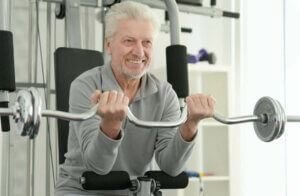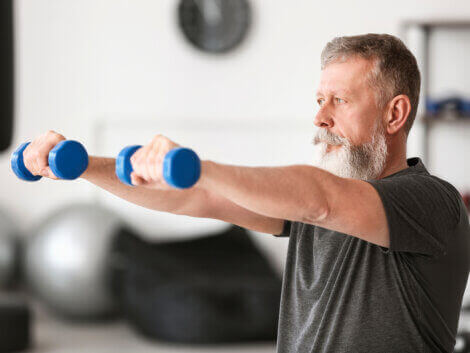The Importance of Lifting Weights After Thirty Years of Age

There are many myths about the practice of lifting weights, some more exaggerated than others. These myths make people neglect this training and, thus, its great benefits, which we’re going to explain in this article.
Why does lifting weights have such a bad reputation? One of the main answers to this common question is the myths we referred to above. In fact, when many people think about this type of training, they imagine a group of overly buff men. However, reality falls short of this.
The importance of lifting weights
There are many ways to train your body in order to enhance your physical abilities. One of them is weight lifting. Thanks to these exercises, you can increase your muscle tone, which enhances strength and endurance.
Of course, you can reap its benefits through a professional and well-developed training plan that takes your abilities into account. In this vein, experts recommend people to avoid lifting weights sporadically or without having any idea of what they’re doing.
Before you lift weights, it’s important that you consult a trainer and get evaluated by a doctor.
Why is lifting weights after age 30 important?
After the age of 30, the body begins to lose muscle tone, capacities such as endurance and strength reduce, and the body perceives these changes as negative.
Age isn’t the only culprit for this decline, although it has a big influence. In fact, a lack of physical exercise, which we could summarize as a sedentary lifestyle, also plays an important role.

Lack of physical activity and regular exercise is the main trigger for a sedentary lifestyle. In fact, it’s a problem that’s plagued people since their youth. However, after the age of 30, other factors, such as the loss of muscle mass due to aging, stand out.
The combination of these factors results in the appearance of sarcopenia, an important disease.
What’s sarcopenia?
It’s a progressive skeletal muscle disease that’s capable of gradually impairing physical performance. Sarcopenia is more dangerous than people think, and muscle groups are prone to it.
Its main causes, which we mentioned above, are age and lack of physical activity. However, there are other triggers for certain disabilities. You need to see a doctor, who’ll request tests and take samples of the affected muscles, to reach a diagnosis.
This condition must be treated with a healthy diet and physical exercise. The latter should include a training plan that can gradually improve muscle tone and contribute to physical abilities.
That’s why lifting weights after age 30 is important. In short, it prevents the appearance of this disease and ensures active aging.
Aging from the age of 30?
Many people consider talking about aging in their 30s excessive. However, the loss of muscle mass that starts at this age is a clear example of this. During each decade, about 10 percent of muscles deteriorate.

Based on what we mentioned above, the ideal thing is to prepare for active aging. You can even start lifting weights gradually before the age of 30, with a well-designed training plan. The goal isn’t to become a weightlifter or overly “buff” but to give this training method the importance it deserves.
Lifting weights is the alternative that experts recommend
This method is important mainly due to how it enhances muscle tone. In fact, it represents an option to stay in shape, even after the age of 60. Clearly, this busts the myth that older adults shouldn’t lift weights. The amount of weight you should lift will vary depending on your muscular capacity.
On the other hand, experts state that people should start lifting weights after the age of 15 years to avoid health problems. The idea is to build a habit before the age of 30 to avoid losing muscle tone or physical abilities over time.
There are many myths about the practice of lifting weights, some more exaggerated than others. These myths make people neglect this training and, thus, its great benefits, which we’re going to explain in this article.
Why does lifting weights have such a bad reputation? One of the main answers to this common question is the myths we referred to above. In fact, when many people think about this type of training, they imagine a group of overly buff men. However, reality falls short of this.
The importance of lifting weights
There are many ways to train your body in order to enhance your physical abilities. One of them is weight lifting. Thanks to these exercises, you can increase your muscle tone, which enhances strength and endurance.
Of course, you can reap its benefits through a professional and well-developed training plan that takes your abilities into account. In this vein, experts recommend people to avoid lifting weights sporadically or without having any idea of what they’re doing.
Before you lift weights, it’s important that you consult a trainer and get evaluated by a doctor.
Why is lifting weights after age 30 important?
After the age of 30, the body begins to lose muscle tone, capacities such as endurance and strength reduce, and the body perceives these changes as negative.
Age isn’t the only culprit for this decline, although it has a big influence. In fact, a lack of physical exercise, which we could summarize as a sedentary lifestyle, also plays an important role.

Lack of physical activity and regular exercise is the main trigger for a sedentary lifestyle. In fact, it’s a problem that’s plagued people since their youth. However, after the age of 30, other factors, such as the loss of muscle mass due to aging, stand out.
The combination of these factors results in the appearance of sarcopenia, an important disease.
What’s sarcopenia?
It’s a progressive skeletal muscle disease that’s capable of gradually impairing physical performance. Sarcopenia is more dangerous than people think, and muscle groups are prone to it.
Its main causes, which we mentioned above, are age and lack of physical activity. However, there are other triggers for certain disabilities. You need to see a doctor, who’ll request tests and take samples of the affected muscles, to reach a diagnosis.
This condition must be treated with a healthy diet and physical exercise. The latter should include a training plan that can gradually improve muscle tone and contribute to physical abilities.
That’s why lifting weights after age 30 is important. In short, it prevents the appearance of this disease and ensures active aging.
Aging from the age of 30?
Many people consider talking about aging in their 30s excessive. However, the loss of muscle mass that starts at this age is a clear example of this. During each decade, about 10 percent of muscles deteriorate.

Based on what we mentioned above, the ideal thing is to prepare for active aging. You can even start lifting weights gradually before the age of 30, with a well-designed training plan. The goal isn’t to become a weightlifter or overly “buff” but to give this training method the importance it deserves.
Lifting weights is the alternative that experts recommend
This method is important mainly due to how it enhances muscle tone. In fact, it represents an option to stay in shape, even after the age of 60. Clearly, this busts the myth that older adults shouldn’t lift weights. The amount of weight you should lift will vary depending on your muscular capacity.
On the other hand, experts state that people should start lifting weights after the age of 15 years to avoid health problems. The idea is to build a habit before the age of 30 to avoid losing muscle tone or physical abilities over time.
All cited sources were thoroughly reviewed by our team to ensure their quality, reliability, currency, and validity. The bibliography of this article was considered reliable and of academic or scientific accuracy.
- Evans, W. J. (1995). What is sarcopenia? Journals of Gerontology – Series A Biological Sciences and Medical Sciences. https://doi.org/10.1093/gerona/50a.special_issue.5
- Michelle M. Porter. 2001. The Effects of Strength Training on Sarcopenia. Canadian Journal of Applied Physiology. https://doi.org/10.1139/h01-009
- José, M. (2012). Envejecimiento activo. Revista Semestral Del Colegio Oficial de Psicólogos de La Comunidad Valenciana. https://doi.org/10.1017/CBO9781107415324.004
This text is provided for informational purposes only and does not replace consultation with a professional. If in doubt, consult your specialist.








